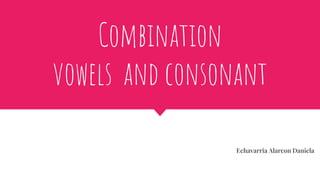
Combination vowels and consonants
- 1. Combination vowels and consonant Echavarria Alarcon Daniela
- 2. Vowel combination Is a combination of two or three vowels, or of a vowel and at least one consonant, that is associated with one or more specific single sounds.
- 3. For example: "ea" has the sounds long e /i:/ and long a /eɪ/; "ay" has the sound long a /eɪ/, and "igh" has the sound long i /ai/. These vowel combinations are sometimes called digraphs, diphthongs, trigraphs, and triphthongs.
- 4. Vowel combinations occur in three different forms in written English: 1- Vowels often appear in clusters within a single syllable. This is the most common form. 2- Vowels often appear in combination with a particular consonant or consonants which, together, represent a sound unit that is different from what you would expect if you didn't know the specific combination. 3- Another common combination in English is one or two vowels followed by "gh". The "gh" is usually silent. It is usually easier to decode the whole unit ("igh", "eigh") than to process the vowel and the "gh" separately.
- 5. Digraphs Vowel digraphs are vowels written with two letters. Some are a single sound. Importance: Diagraphs are considered nearly equal to the letters of the standard alphabet in importance to learning to read and write in English. Experts have indicated the difficulty that learning digraphs presents to English language learners. For example, according to Roberta Heembrock in "Why Kids Can't Spell," the digraph ch can be pronounced at least four different ways: k (character), sh (chute), kw (choir), and ch (chain).
- 6. Common vowel digraphs: ai (rain), ay (day), ea (teach), ea (bread), ea (break), ee (free), ei (eight), ey (key), ie (piece), oa (road), oo (book), oo (room), ow (slow), and ue (true).
- 7. There are eight primary diphthongs in the English language, according to TutorEd and Stack Exchange. They are: /eɪ/ as in day, pay, say, lay /aɪ/ as in sky, buy, cry, tie /ɔɪ/ as in boy, toy, coy or the first syllable of soya /ɪə/ as in beer, pier, hear /eə/ as in bear, pair, and hair /ʊə/ as in tour, poor or the first syllable of tourist /əʊ/ as in oh, no, so, or phone /aʊ/ as in all the words of "How now brown cow!"
- 8. Trigraphs There are blended sounds in English where vowels make three distinct sounds in a single syllable, called triphthongs. Some examples provided by English EFL include: /eɪə/ as in layer, player /aɪə/ as in lire, fire /ɔɪə/ as in loyal, royal /əuə/ as in lower, mower /auə/ as in power, hour
- 9. That extra, or third, symbol that indicates that these are triphthongs, "ə," is a phoneme called a schwa and is roughly pronounced "uh."
- 10. Example
- 11. Triphthongs
- 12. Example
- 13. Exercise
- 14. Consonant The first set of symbols presented here represents consonant sounds. Most are fundamental to English pronunciation regardless of accent. Since you might be unfamiliar with some of the terms used to describe the sounds, here are some definitions you might find useful:
- 15. Voiced: a voiced sound is a sound where the vocal cords vibrate, thus producing some sort of pitch. This is the kind of sound most people associate with regular talking or singing. Voiceless / unvoiced: a voiceless or unvoiced sound is one where the vocal cords do not vibrate, thus making the sound very whispery and without a pitch. It can tend to make a letter sound harsher when pronounced.
- 16. Stop: a consonant sound where the airflow is stopped completely by the mouth and then sharply released. Think of sounds like “p,” “k,” and “t.” All languages contain stops. Fricative: a consonant sound where the airflow becomes noisy and turbulent because it only has a very small space to travel through in the mouth. Think of sounds like “f,” “s,” and “sh.” Most languages have fricatives, but not all.
- 17. Nasal: a consonant sound where the airflow passes exclusively through the nose instead of the mouth. Think of sounds like “m,” “n,” or “ng.” Almost all languages have nasals. Affricate: a consonant sound that begins like a stop but then releases like a fricative, thus making it a sort of combination sound. Think of sounds like “ch” and “j.” Affricates are common, especially in English.
- 18. Alveolar ridge: a ridge found on the roof of the mouth between the upper teeth and the hard palate, which is used in conjunction with the tip of the tongue to make many sounds Soft palate: the soft tissue in the back of the roof of your mouth, which is used In conjunction with the back of the tongue to make many sounds. Glottis: the part of the larynx (air passage) that contains the vocal cords and the opening between them.
- 21. Exercise